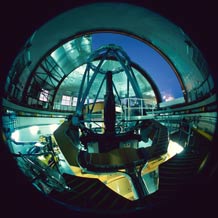Articles

The Wide Field Camera (long black tube) on the United Kingdom Infrared Telescope on Mauna Kea, Hawaii. Credit: UKIRT/JAC.
Exeter scientists help discover most distant cosmic explosion ever seen
Astrophysicists from the University of Exeter are involved in the discovery of the most distant cosmic explosion ever seen.
The NASA/STFC/ASI Swift satellite has found a gamma-ray burst from a star that died when the Universe was 640 million years old, or less than five percent of its present age. The international team, led by UK and US astronomers, has dubbed the discovery GRB 09042. The discovery gives astronomers an insight into the early Universe.
Gamma-ray bursts are the Universe's most luminous explosions. Most occur when massive stars run out of nuclear fuel. As their cores collapse into a black hole or neutron star, gas jets - driven by processes not fully understood - punch through the star and blast into space. There, they strike gas previously shed by the star and heat it, which generates short-lived afterglows in other wavelengths.
An automated software system called eSTAR is run by Exeter astronomers Dr Alasdair Allan and Professor Tim Naylor and links telescopes from around the world. It picked up the gamma-ray burst alert from the Swift satellite, and calculated that the STFC’s United Kingdom Infrared Telescope UKIRT) on Mauna Kea, Hawaii could observe exactly the right spot in the sky. It then sent the telescope detailed instructions as to what was required.
Twenty minutes after the burst, UKIRT was pointing at the patch in the sky where the gamma-rays had come from and detected an infrared “afterglow” from the explosion. This was in stark contrast to other groups who used optical telescopes, and saw only an apparently blank piece of sky at the position reported by Swift. As more groups observed the source, the UKIRT team’s finding was confirmed, the source appeared in the longer-wavelength infrared images, but was absent in shorter-wavelength (optical) images. This is because the early universe is opaque to these wavelengths, and the longer the wavelength you must to use to see an object, the older it is. In this case the cut-off corresponded to a burst distance of about 13 billion light-years. As word spread about the record distance, telescopes around the world slewed toward GRB 090423 to observe the afterglow before it faded away.
Professor Tim Naylor of the University of Exeter’s Astrophysics Group said: “At 07:55:19UT on Thursday morning I was arranging the day’s meetings (I am Head of Physics at Exeter, as well as a research astronomer), completely unaware that the system we have spent years creating, and which spends many months silently waiting, had sprung into action and a telescope on the other side of the world was observing light from the most distant object ever detected. It’s the sort of astronomy Alasdair and I dreamt of, and others told us was science fiction, when we first suggested the eSTAR system.”
“This is the most remote gamma-ray burst ever detected, and also the most distant object ever discovered — by some way,” said Professor Nial Tanvir, of the University of Leicester.
The UK researchers are supported by the Science and Technology Facilities Council (STFC) which also funds the UK contribution to Swift, subscriptions to ESO and Gemini and owns the UK Infrared Telescope (UKIRT). Key parts of the instrumentation on Swift were built at the University of Leicester and University College London's Mullard Space Science Laboratory. Leicester also houses the UK Swift Science Data Centre which provided the most accurate X-ray location for GRB090423
The University of Exeter has one of the UK’s largest astrophysics groups working in the fields of star formation and exoplanet research. The group focuses on one of the most fundamental problems in modern astronomy – when do stars and planets form and how does it happen? They conduct observations with the world’s leading telescopes and carry out numerical simulations to study young stars, their planet-forming discs, and exoplanets. This research helps to put our Sun and the solar system into context and understand the variety of stars and planetary systems that exist in our Galaxy. Over the next three years, the University is investing £80 million in five areas of interdisciplinary scientific research, one of which is Extrasolar Planets.
Date: 27 April 2009
